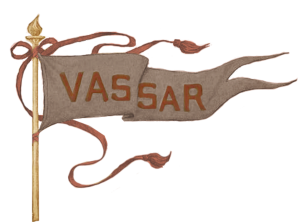Edward Robert Linner joined the Vassar faculty in 1934 as an instructor in chemistry. Born to Swedish parents in Buffalo in 1899, he had to put himself through the University
of Buffalo by holding a full-time job as chemist for the
Acheson Graphite Company. His graduate studies, begun in
1925 at the University of Wisconsin, were interrupted by
the need to take a teaching post at Lafayette College.
In l93l an appointment as instructor of biochemistry at
the University of Minnesota allowed him to resume graduate work and to bring Celestia Davidson of Buffalo west to be his wife.
During his 3l years on the Vassar faculty, Ed Linner pursued his research interest in physical biochemistry,
notably in adsorption phenomena. One of his happiest years
spent in l949-50 under a joint Vassar Faculty Fellow-
ship and a study grant from the American-Scandinavian
Foundation, at the Biochemical Institute in Upsala in Sweden
where he worked with Arne Tiselius who had the year before
won the Nobel Prize in chemistry. But Ed's deepest commit-
ment was always to his students and his greatest talent was
that of a remarkable teacher. He saw no contradiction in
rigorous mathematical thinking and an undisguised awe at
the beauty of the workings of nature laid bare by the human
mind. He would derive a complex equation on the blackboard and turn to his class to ask: “Isn’t that beautiful?” And he
had boundless patience in conveying to his students an
understanding and an appreciation of the stark aesthetics of a subject that those who do not know and love it may
consider dry.
His love for his students, his colleagues and, yea,
even for administrators combined in a love for Vassar
College that was right as it is rare. He knew how to love an institution, knew what that meant. His Vassar was not one of bricks and mortar, of administrative bureau-
crazy or of tradition writ large in sacred letters; it was the sum of all the lives given to it. A fitting gratitude to those who have gone before, and a proper resposibility to those who will come after, demand that one give one’s best to the College in all ways. That is what Ed un-
failingly did, and most visibly during his seven-year ser-vice as chairman of the Committee on Admissions. At that
time--in the fifties—the appointed faculty chairman was
in charge of the College admissions policies and practices,
with the Director of Admissions serving under faculty di-
rection. For the last two years of that period, Ed was
both Chairman and Director of Admissions. Under his aegis
Vassar changed from a college drawing its students primarily
from a well-defined group of private schools to one that
brought together a nearly equal mix of private and public school students.
-2-
Ed Linner’s definition of education had always included breadth as well as depth. He was an accomplished musician himself, and there can have been few concerts at Vassar in almost 50 years at which Ed and Celestia were not in the audience. He was widely read in English history and literature and in his later years embarked on a study of the history of chemistry in the late 18th and early 19th centuries. The focus was on Sir Humphrey Davy, a man after his own heart. Davy was a close friend of the Lake Poets; indeed, Wordsworth turned to him for help with punctuation. Davy also worked with a number of influential English scientists, including William Hyde Wollaston, Thomas Beddoes and Thomas Wedgewood. Ed spent his second faculty leave in ’63/64 in the Reading Room of the British Museum Library, but in the course of that project, his mind took another characteristic turn. In the Vassar Library he found an early-19th century textbook of chemistry by Thomas Thomson (1773-1852) that had belonged to Matthew Vassar. Intrigued by the founder’s interest in his own subkect, Ed made a study of Matthew Vassar’s library and, after his retirement in 1965, went on to write four long essays on the formative history of the College. In this work, he profited from the advice and encouragement of Betty Daniels and of other colleagues who shared his interest in the College’s history. After Ed’s death in 1983 it was Betty who edited those essays and saw to their publication in 1984 under the title, Vassar, the Remarkable Growth of a Man and His College, 1855-1865.
What remains to be said about Ed Linner is the most
important and the most difficult to convey to those who did
not know him. He was a man of simple manner, but he was
not a simple man. He had a great and irreverent sense of
fun: life was fun, work was fun. But he was more serious
than most in his commitments and in his values. His sense
of rectitude and honor was so deeply embedded in his char-
acter that he took it to be natural and universal. When
Peeple behaved badly, he might have to admit that they were
imperfect, but he refused to think them worse than that.
He loved to tell stories but would not traffic in gossip.
He had a sharp eye for the difference between dignity and
stuffiness. He detested posturing and pomposity and took
delight in puncturing it, but he had much affection and
affinity for genuine eecentricity. Most remarkably, he
seemed to be unaware of anyone's age, including his own
He treated small children as equals, enjoyed their company and astounded them by eating his shoelaces (which were of licorice). He never forgot the welcoming attention given him as a young instructor by the senior faculty, starting with Prexy McCracken, and he returned it to newly arrived colleagues with disarming warmth and directness. He liked people without having to make them over to his specifications. And he maintained his own uncompromising standard of conduct without relinquishing his genoristy of mind and spirit.
John Christie
Joe Mucci
Curt Beck
May 8, 1985

